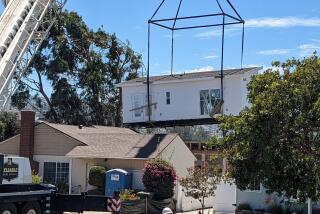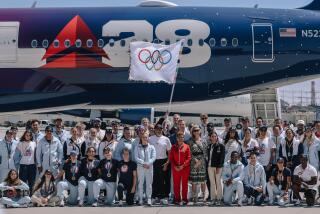In L.A., getting paid to go green
Atop a beige apartment complex in North Hollywood, rows of solar panels began providing energy Wednesday as part of what backers say is the nation’s largest urban rooftop solar program.
Called Clean L.A. Solar, the program allows the Los Angeles Department of Water and Power to pay customers to generate solar power across the city’s vast expanse of flat roof space.
The goal of the effort, the brainchild of the Los Angeles Business Council, is to generate 150 megawatts of solar electricity, or enough to power about 30,000 homes. The council hopes to attract investments totaling $500 million from a growing list of companies that want to invest in L.A.’s push to go green by setting up large clusters of rooftop solar panels.
“It is really a no-brainer,” said Christian Wentzel, chief executive of Solar Provider Group, which installed the North Hollywood panels. Long-term contracts with the DWP cemented the Los Angeles company’s plans to invest $50 million in 17 projects to tap the region’s sun-drenched climate.
Four years in the making, Clean L.A. Solar serves as part of the city’s answer to the state mandate to generate 33% of electricity using renewable sources by 2020. DWP officials project the solar purchasing program will help L.A. reach 25% of the state mandate by 2016.
Clean L.A. Solar proponents have their sights set high, aiming to expand the initial 150-megawatt goal over the next several years to 600 megawatts. Mayor-elect Eric Garcetti voiced support for the upgrade during his campaign in January.
“If we have political commitments to expand, you’re going to see a large amount of the industry come in and commit resources. This lowers the cost of solar over the long-term,” Wentzel said, “and that can only benefit Angelenos.”
Wentzel said Solar Provider Group would hire 30 people locally to operate its planned projects, with jobs including engineers, project managers, construction workers and sales representatives. The business council estimates Clean L.A. Solar will create about 4,300 jobs.
Mary Leslie, president of the council, said several studies conducted in collaboration with UCLA and USC revealed a waste of solar power training programs in the city, preparing Angelenos for jobs in a green market too small to employ them.
“At any one point a year and a half ago,” Leslie said, “we had 1,300 solar installers in training. About half were working, and of that half, many were having to go outside of the county to find work.”
Further studies determined the city’s neighborhoods with the highest amounts of light available also tended to overlap with L.A.’s lower-income communities, neighborhoods that could likely benefit from more job opportunities.
Many of these areas, or “hot spots,” are home to the programs that offer solar power training, such as those by Homeboy Industries and local chapters of the International Brotherhood of Electrical Workers. Leslie said so far, 20 of the 35 approved solar projects were in hot spots.
Despite those potential gains, Clean L.A. Solar has its share of critics. DWP ratepayer advocate Fred Pickel warned the utility would be paying companies much more than necessary for the electricity, which he said would fall on DWP customers.
DWP General Manager Ron Nichols said Pickel’s numbers were off, and that the utility had carefully researched market prices and the results of a competitive bidding process during the demonstration phase last year to set the current rate.
Initially, customers generating power in the city will receive 17 cents a kilowatt-hour, a price that gradually will decline for later projects to 14 cents; projects in Owens Valley, also home to DWP ratepayers, will receive 14 cents a kilowatt-hour. Single-family homes probably won’t be able to participate because most aren’t large enough.
“We’ve acknowledged we’re paying a slightly higher incentive to make absolute certain we get major players here,” Nichols said. “We’re starting a pioneering program. We didn’t want to put out a price, hold a party and nobody comes.”
Jim Jenal, founder and chief executive of rooftop solar company Run on Sun in Pasadena, said he worries the program will leave the city’s nonprofits in the lurch.
Clean L.A. Solar carved out four megawatts for smaller projects, such as the North Hollywood apartment building. These can generate anywhere from 30 to 150 kilowatts per hour. The remaining 16 megawatts in the first portion of the program were reserved for large projects that can generate 150 kilowatts to 3 megawatts per hour.
Jenal said it’s hard for small entities to carry the financial burden of installing and maintaining solar projects. Nonprofits are ineligible for the tax breaks that most large commercial entities use to increase the return they see off their green endeavors.
Jenal said that could hamstring a key objective of the solar program: familiarizing the public with alternative energy sources.
“What the LADWP did right is to see this as a way to get solar throughout a lot of different places in the city. It demystifies the whole concept,” Jenal said. “From the stated goal, there is no place better than nonprofits -- places where people come to congregate, come to learn -- for them to learn about the value of sustainable energy.”
Leslie of the LABC said residents and smaller organizations that can’t shoulder the cost of a full solar installation can still invest as shareholders in nearby projects, and would see a return once these projects become profitable.
“We didn’t want a program that would only be for a select part of the city,” Leslie said. “We want to make sure that solar is diverse.”
“We have sunshine over 300 days a year. The sun’s free,” she said, “so the better we get at harnessing it, the better off we’re going to be.”
--
Twitter: @c_s_green
More to Read
Inside the business of entertainment
The Wide Shot brings you news, analysis and insights on everything from streaming wars to production — and what it all means for the future.
You may occasionally receive promotional content from the Los Angeles Times.










